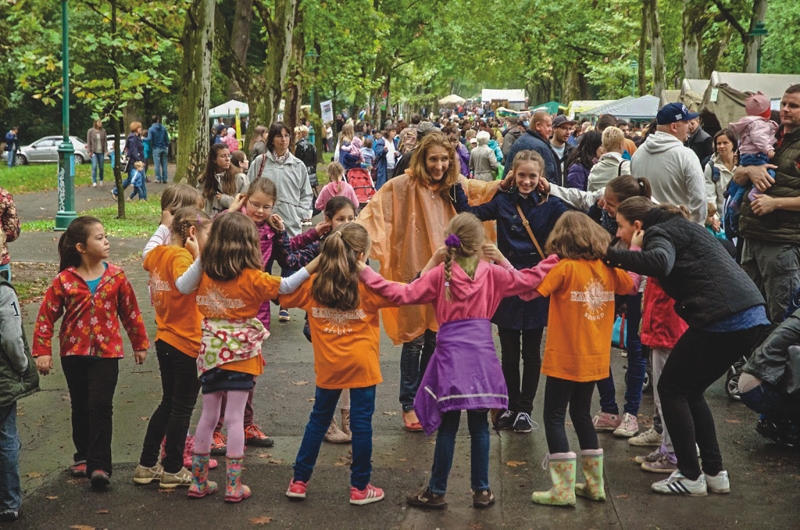
Jan 26, 2016 | Focolare Worldwide
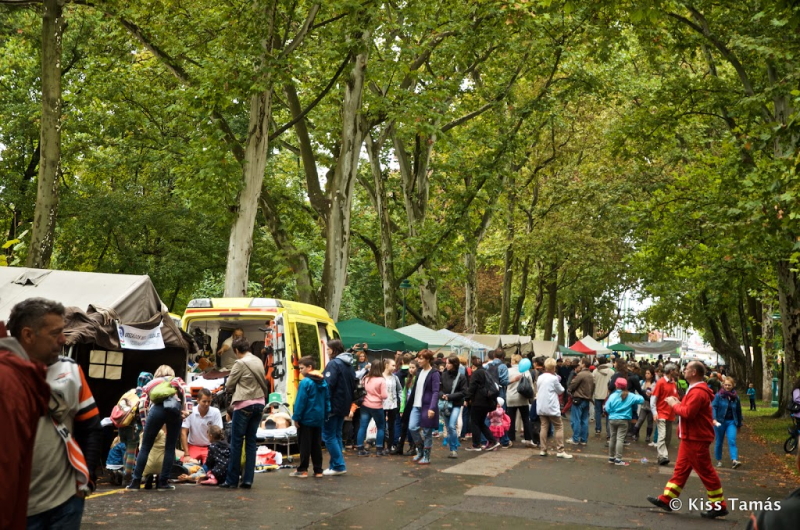 The festival took place in the park of Szeged, city in the south of Hungary and was “the biggest open-air, free of charge event of the year .” It was publicized at the Open Air Festival, in a press release, and distinguished itself for the great number of participants and performances. But what was the novelty of this event? «When, a few years ago they announced for the first time a possible Christian manifestation at city-level, no one thought that such an ambitious project could ever come about in our country, », wrote Új Város, the Focolare Magazine in Hungary. «It was not just the dream of a single person, but of the ecumenical group of pastors of that city. A dream which, a year and a half ago, started to take form, involving various religious, civil and political associations, » until it gave rise to the Festival held from 25 to 27 September. As Orsolya Szlaukó, an evangelical lady-pastor affirmed: «In Szeged, the ecumenical group of pastors that lance the idea of organising something that would announce Christianity. The logo and four colours and also the entire Festival drew inspiration from a Psalm: “the Lord led me out ” (Psalm, 18). We dreamt and thought of making a gift to the inhabitants of Szeged, by showing the unity of the Christian churches and the values of these communities. ». An organizer affirmed; «Our mission addresses the city and not only our communities», and another organizer, Sándor Tari added: «Our role was to ensure the good flow of the event, and not that of being in the limelight.» Another organizer added: «During the Festival each of us found the program which suited him best, from the youth to the elderly, » and the lady-pastor concluded: «We made room for concerts, round tables, playgrounds and stands of various organizations. ». «The 60 stands disseminated like huts along the park’s avenues, formed four city districts that showed the visitors the initiatives under way: an electrician held a workshop for kids, a healthcare stand which was visited by 700 people, with blood donation, and there were university professors who gave lessons. The parishes and the ecclesial communities held a great variety of creative initiatives.»
The festival took place in the park of Szeged, city in the south of Hungary and was “the biggest open-air, free of charge event of the year .” It was publicized at the Open Air Festival, in a press release, and distinguished itself for the great number of participants and performances. But what was the novelty of this event? «When, a few years ago they announced for the first time a possible Christian manifestation at city-level, no one thought that such an ambitious project could ever come about in our country, », wrote Új Város, the Focolare Magazine in Hungary. «It was not just the dream of a single person, but of the ecumenical group of pastors of that city. A dream which, a year and a half ago, started to take form, involving various religious, civil and political associations, » until it gave rise to the Festival held from 25 to 27 September. As Orsolya Szlaukó, an evangelical lady-pastor affirmed: «In Szeged, the ecumenical group of pastors that lance the idea of organising something that would announce Christianity. The logo and four colours and also the entire Festival drew inspiration from a Psalm: “the Lord led me out ” (Psalm, 18). We dreamt and thought of making a gift to the inhabitants of Szeged, by showing the unity of the Christian churches and the values of these communities. ». An organizer affirmed; «Our mission addresses the city and not only our communities», and another organizer, Sándor Tari added: «Our role was to ensure the good flow of the event, and not that of being in the limelight.» Another organizer added: «During the Festival each of us found the program which suited him best, from the youth to the elderly, » and the lady-pastor concluded: «We made room for concerts, round tables, playgrounds and stands of various organizations. ». «The 60 stands disseminated like huts along the park’s avenues, formed four city districts that showed the visitors the initiatives under way: an electrician held a workshop for kids, a healthcare stand which was visited by 700 people, with blood donation, and there were university professors who gave lessons. The parishes and the ecclesial communities held a great variety of creative initiatives.»  Sándor Tari worked for a whole year on the setup of the stands area. «The aim was to represent every sector of the city: from the farmers, labourers, culture, healthcare… The condition set for the exhibition stands was to be open to friendship with the organisers and among themselves. Also the Police and Fire-fighters participated.» Sándor recounted that among the projects was to continue and probably hold another similar event in two years time. «I really liked the family atmosphere with many parents and children, » the father of a family said. But also the youth had a range of choices between the various bands that performed on stage, among which Gen Verde, Hillsong and Hungarian music groups. «Here there is an atmosphere we do not see every day, and listening to them one can feel peace in the bottom of our hearts », a young man said. The evangelical bishop Péter Gáncs, in an interview with the Duna TV Channel explained why he believed it was important for him to participate : «From the start, I liked the title of the Festival, Open Space. At times I have the impression that the churches are afraid to go all out. 25 years after the change of regime, we see that people still do not willingly go to church. So we are the ones who have to go out. That’s why I really appreciated this ecumenical get-together to go out into the square, into the streets. ». Source: Új Város n.1/2016
Sándor Tari worked for a whole year on the setup of the stands area. «The aim was to represent every sector of the city: from the farmers, labourers, culture, healthcare… The condition set for the exhibition stands was to be open to friendship with the organisers and among themselves. Also the Police and Fire-fighters participated.» Sándor recounted that among the projects was to continue and probably hold another similar event in two years time. «I really liked the family atmosphere with many parents and children, » the father of a family said. But also the youth had a range of choices between the various bands that performed on stage, among which Gen Verde, Hillsong and Hungarian music groups. «Here there is an atmosphere we do not see every day, and listening to them one can feel peace in the bottom of our hearts », a young man said. The evangelical bishop Péter Gáncs, in an interview with the Duna TV Channel explained why he believed it was important for him to participate : «From the start, I liked the title of the Festival, Open Space. At times I have the impression that the churches are afraid to go all out. 25 years after the change of regime, we see that people still do not willingly go to church. So we are the ones who have to go out. That’s why I really appreciated this ecumenical get-together to go out into the square, into the streets. ». Source: Új Város n.1/2016
![Argentina: Misael and his dream of peace]()
Jan 25, 2016 | Focolare Worldwide, Senza categoria
 “I teach in a Catholic school in my city, Salta, in northern Argentina,” says Gabriela Carral. “In early October of 2015, I met Misael, a 10 year old student, following a prayer service held by Orthodox and Catholics for peace in Syria. At that particular time, the image of the lifeless body of the little Syrian boy, Aylan, had made the headlines globally through the mass media. Misael told me he wanted to do something for peace in our school, adding that what hurt him most of all was knowing that so many children were orphaned by the war. We arranged to meet at recreation time. He explained that he was part of the Orthodox community, and that he was convinced that we should pray for peace: Catholics and Orthodox together. A few days later, he showed me a flyer that he had in his folder. The text read: “Syria is us. Let us for peace.” I was surprised to see that a child, in the midst of almost 800 pupils in elementary and secondary schools, could be so sensitive to the pain of people suffering thousands of kilometers away. I liked his idea and I encouraged him to share it with the school principal and staff. The outcome was a plan to organise an ecumenical prayer for peace. For the first time the word ecumenism resounded in the halls of this school, among the leaders, teachers and students.
“I teach in a Catholic school in my city, Salta, in northern Argentina,” says Gabriela Carral. “In early October of 2015, I met Misael, a 10 year old student, following a prayer service held by Orthodox and Catholics for peace in Syria. At that particular time, the image of the lifeless body of the little Syrian boy, Aylan, had made the headlines globally through the mass media. Misael told me he wanted to do something for peace in our school, adding that what hurt him most of all was knowing that so many children were orphaned by the war. We arranged to meet at recreation time. He explained that he was part of the Orthodox community, and that he was convinced that we should pray for peace: Catholics and Orthodox together. A few days later, he showed me a flyer that he had in his folder. The text read: “Syria is us. Let us for peace.” I was surprised to see that a child, in the midst of almost 800 pupils in elementary and secondary schools, could be so sensitive to the pain of people suffering thousands of kilometers away. I liked his idea and I encouraged him to share it with the school principal and staff. The outcome was a plan to organise an ecumenical prayer for peace. For the first time the word ecumenism resounded in the halls of this school, among the leaders, teachers and students. 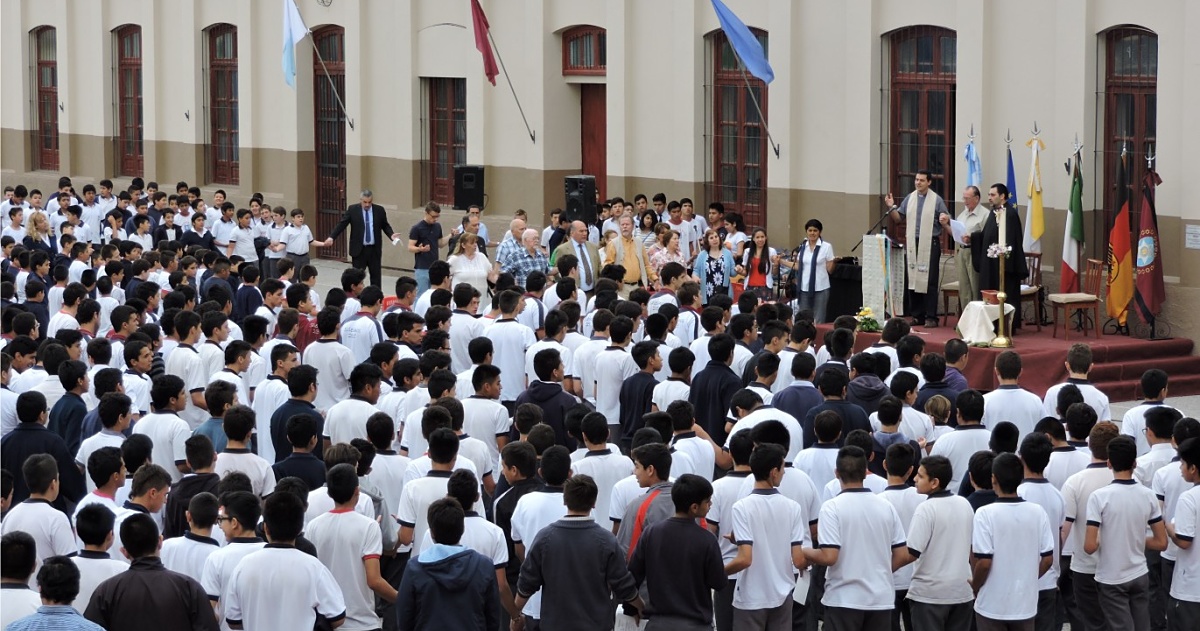 In order to put this plan into action, I contacted a religious order priest who shares my goal in trying to live the prayer of Jesus: “That all may be one”. Fr Adolfo, from the Orthodox Church of Antioch, also got involved, and together we organized every detail of the celebration. Subsequently the Lutheran Church asked to join us since our school community includes a young Lutheran volunteer from Germany. Others then showed interest in the event, such as the president of the local Syrian-Lebanese community, the German consul and the vice-consul of Italy, a representative from the Ministry of Education, newspaper journalists and the heads of other schools. The first step of Misael’s project was that of trying to build peace in our everyday relationships, and this gave rise to many new experiences lived among the children to which we also proposed the Time Out prayer for peace promoted by Youth for a United World. Through the homilies given by the celebrants, we shared in the life of Christians in Syria and Africa; the intentions for peace were read out by a young Orthodox girl while a woman recited the Lord’s Prayer in Arabic. The flags of the different countries which were hoisted up warmed our hearts and made us feel like members of the one human family. In short, it was a celebration that enabled each of one us to experience something that we had not experienced so strongly beforehand: profound friendships and unimaginable bonds. The school principle and staff of the school called it a historic day. “We thank God for our freedom,” concluded the young people present, “and we promise not to ever take sides but to stand on the side of peace.” Gustavo Clariá
In order to put this plan into action, I contacted a religious order priest who shares my goal in trying to live the prayer of Jesus: “That all may be one”. Fr Adolfo, from the Orthodox Church of Antioch, also got involved, and together we organized every detail of the celebration. Subsequently the Lutheran Church asked to join us since our school community includes a young Lutheran volunteer from Germany. Others then showed interest in the event, such as the president of the local Syrian-Lebanese community, the German consul and the vice-consul of Italy, a representative from the Ministry of Education, newspaper journalists and the heads of other schools. The first step of Misael’s project was that of trying to build peace in our everyday relationships, and this gave rise to many new experiences lived among the children to which we also proposed the Time Out prayer for peace promoted by Youth for a United World. Through the homilies given by the celebrants, we shared in the life of Christians in Syria and Africa; the intentions for peace were read out by a young Orthodox girl while a woman recited the Lord’s Prayer in Arabic. The flags of the different countries which were hoisted up warmed our hearts and made us feel like members of the one human family. In short, it was a celebration that enabled each of one us to experience something that we had not experienced so strongly beforehand: profound friendships and unimaginable bonds. The school principle and staff of the school called it a historic day. “We thank God for our freedom,” concluded the young people present, “and we promise not to ever take sides but to stand on the side of peace.” Gustavo Clariá
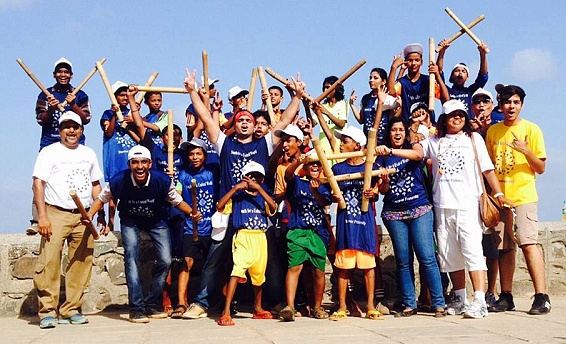
Jan 23, 2016 | Focolare Worldwide
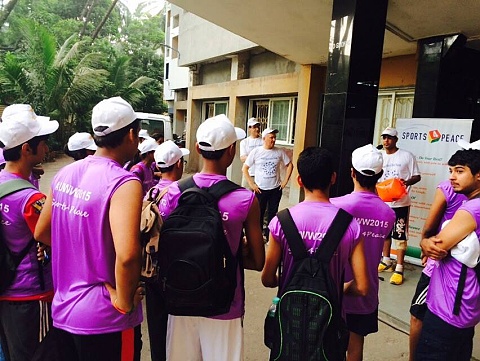 “Sport can really change the world and make it more united”. Patsy Furtado, a hockey coach from Mumbai who once played for the Indian national hockey team, speaks with the strong conviction that comes from an equally strong experience lived with street children in this immense metropolis. She had met the Focolare and the idea of Sportmeet through a Run4unity event in 2005. Her passion for sports and the experience of unity lived that day fuelled her desire to join forces with other like-minded coaches and bring about change in the surrounding area, where children often can be seen living on the streets. She had just got to know a home for destitute children with 240 children, neglected by society. She got the idea to start coaching them in different sports: football, basketball, hockey, athletics … Every morning at 6.30am they started having a one hour training session. Initially there were 20 girls and 30 boys who came for training without shoes and proper sports gear. Today there are a number of teams, all having proper sport shoes, gear and kit bag. In 2007 they entered the inter-school competition at the all Mumbai level and the under-12 football team stood eighth in Mumbai among over 300 schools. This achievement made it to the Hindustan Times, one of Mumbai’s major newspapers, with the heading “United We Stand”. Listing the numerous achievements of this project, Patsy points to the fact that the children’s behaviour improved tremendously: sports taught them to be disciplined and after playing sports all their energy is used in the right way. Whereas it would be natural to be violent and aggressive with a background like theirs, they become confident and have self respect, they look after their hygiene and take responsibilities. Coming from various religions the children come together to play as a team and there are no differences among them.
“Sport can really change the world and make it more united”. Patsy Furtado, a hockey coach from Mumbai who once played for the Indian national hockey team, speaks with the strong conviction that comes from an equally strong experience lived with street children in this immense metropolis. She had met the Focolare and the idea of Sportmeet through a Run4unity event in 2005. Her passion for sports and the experience of unity lived that day fuelled her desire to join forces with other like-minded coaches and bring about change in the surrounding area, where children often can be seen living on the streets. She had just got to know a home for destitute children with 240 children, neglected by society. She got the idea to start coaching them in different sports: football, basketball, hockey, athletics … Every morning at 6.30am they started having a one hour training session. Initially there were 20 girls and 30 boys who came for training without shoes and proper sports gear. Today there are a number of teams, all having proper sport shoes, gear and kit bag. In 2007 they entered the inter-school competition at the all Mumbai level and the under-12 football team stood eighth in Mumbai among over 300 schools. This achievement made it to the Hindustan Times, one of Mumbai’s major newspapers, with the heading “United We Stand”. Listing the numerous achievements of this project, Patsy points to the fact that the children’s behaviour improved tremendously: sports taught them to be disciplined and after playing sports all their energy is used in the right way. Whereas it would be natural to be violent and aggressive with a background like theirs, they become confident and have self respect, they look after their hygiene and take responsibilities. Coming from various religions the children come together to play as a team and there are no differences among them.  In 2009 the first Sports4Peace workshop was held in Mumbai. Promoting a cube with 6 rules to educate for Peace through sports, the idea of Sports4Peace captured the imagination of various coaches and others engaged in the field of sports in Mumbai and other cities in India. “Play well”, “Hang in there”, “Look out for others”: simple rules which have touched the lives and inspired several youth and sport enthusiasts to apply them with passion in their various disciplines. The idea of Sports4Peace became part of various interreligious cultural college activities as well as diocesan events in Mumbai and in Pune, a neighbouring city known for its numerous colleges. Presented in various Run4Unity editions also in Delhi, it was promoted in the recent United World Week hosted in Mumbai in May 2015, when a permanent Sports4Peace cube was installed in a prominent place in a public garden on Mumbai’s popular Bandstand promenade to remind all that sports, lived and played well, can promote peace and universal brotherhood. Gustavo Clariá
In 2009 the first Sports4Peace workshop was held in Mumbai. Promoting a cube with 6 rules to educate for Peace through sports, the idea of Sports4Peace captured the imagination of various coaches and others engaged in the field of sports in Mumbai and other cities in India. “Play well”, “Hang in there”, “Look out for others”: simple rules which have touched the lives and inspired several youth and sport enthusiasts to apply them with passion in their various disciplines. The idea of Sports4Peace became part of various interreligious cultural college activities as well as diocesan events in Mumbai and in Pune, a neighbouring city known for its numerous colleges. Presented in various Run4Unity editions also in Delhi, it was promoted in the recent United World Week hosted in Mumbai in May 2015, when a permanent Sports4Peace cube was installed in a prominent place in a public garden on Mumbai’s popular Bandstand promenade to remind all that sports, lived and played well, can promote peace and universal brotherhood. Gustavo Clariá
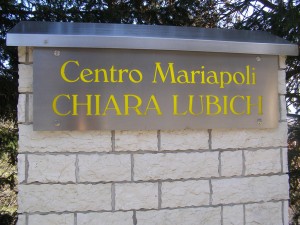
Jan 23, 2016 | Focolare Worldwide
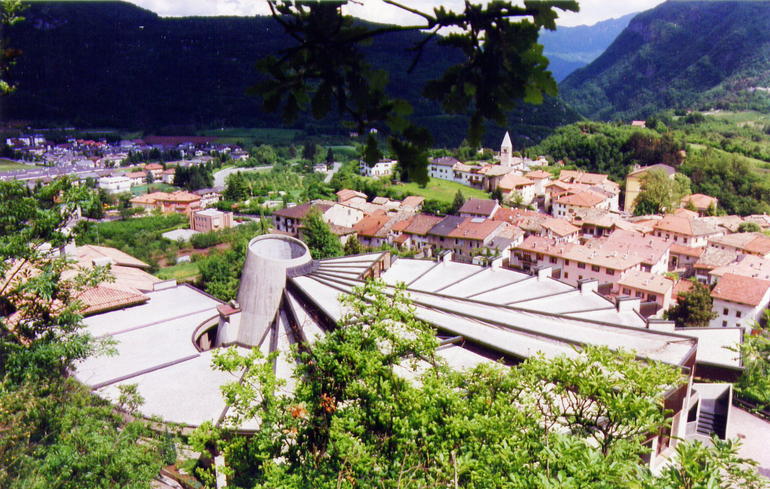 “This the house built on the rocks, (Word of Life) will remind us of the one Jesus spoke about. Winds and storms may blow but it will not collapse,” Chiara Lubich said on 24 May 1986 at the inauguration of the Mariapolis Centre of her birthplace. 23 January 2016: it will be a feast day at the Centre which is today dedicated to her, in memory of 30 years of history, testimonials, dialogue and communion in the light of the charisma of unity. The event will open with the message of Maria Voce and a video that traces almost 30 years of history. Then there will be some testimonials of the local members of the Movement in the civil and ecclesial fields, and the greetings of the Archbishop of Trent, Bishop Luigi Bressan, and the Mayor, Alessandro Andreatta, and other authorities. After 30 years, the Centre of Cadine has been faithful to its own vocation: to be a place of encounter and formation for those who wish to commit their lives to irradiating the life of the Gospel and bringing back through mutual love, the presence of God in the world. Flashback to the past. In the 1970s the Focolare Movement, diffused throughout the region, felt the need for a formation centre. After various futile searches, efforts were focused on Trent. When she was told about this, Chiara responded: “I had always thought of it as a city chosen by God.” A few months later the entire Movement was living the Word of Life: “Sell all you have, and give it to the poor.” The desire to put this Word of the Gospel into practice pushed Nostra Fadanelli, a follower of the Movement, to donate nine hectares of a wood for the construction of the Mariapolis Centre. The design was entrusted to Carlo Fumagalli, a focolarino architect who, with the awareness of having to build a Centre in the city where the Movement was born, traced the stages of her history in Trent and in the Primiero Valley, reproducing some details in the building’s architecture. The project was presented to the Archbishop at that time, Bishop Gottardi who said: “This has to be a ”monument” to Chiara Lubich, of course, when she will be in Paradise. And it will be the best monument if, with regard to the history of Trent, it will be… a Mariapolis with an “ecumenical flair,” and link up to the ecumenical mandate of the City of Trent, expressed by Pope Paul VI in 1964. And he concluded: “You have this mission!” From that moment on, the generosity of each member of the Movement started circulating, each with his own possibilities and the fantasy of those who build their “own” house. In October 1980, while the bureaucratic procedures were underway, news arrived that they were looking for a house for the International Mariapolis Centre. So they all decided to donate the funds collected up to then: a big sum which surprised Chiara herself. It seemed to be a crazy idea, but upon acquiring the permits to build, a new and substantial sum arrived, three times what they had given, which made them experience the promises of the Gospel: “Give and you shall be given.” So in 1982, the day section of the building of the centre started: the foyer, meeting halls, kitchen and dining room. Everyone wanted to help, giving their time and forces, and in the last year of the works, about 800 people alternated with the artisanal works, finishing and workforce. A memorable day was when the road and square were paved with porphyry, which was finished the day before the inauguration. On 24 May 1986, before about 2,000 people, among whom were representatives of the most important churches in Europe, Chiara herself inaugurated the Mariapolis Centre, underlining its ecumenical and formative vocation, and called the centre, “Word of Life.”
“This the house built on the rocks, (Word of Life) will remind us of the one Jesus spoke about. Winds and storms may blow but it will not collapse,” Chiara Lubich said on 24 May 1986 at the inauguration of the Mariapolis Centre of her birthplace. 23 January 2016: it will be a feast day at the Centre which is today dedicated to her, in memory of 30 years of history, testimonials, dialogue and communion in the light of the charisma of unity. The event will open with the message of Maria Voce and a video that traces almost 30 years of history. Then there will be some testimonials of the local members of the Movement in the civil and ecclesial fields, and the greetings of the Archbishop of Trent, Bishop Luigi Bressan, and the Mayor, Alessandro Andreatta, and other authorities. After 30 years, the Centre of Cadine has been faithful to its own vocation: to be a place of encounter and formation for those who wish to commit their lives to irradiating the life of the Gospel and bringing back through mutual love, the presence of God in the world. Flashback to the past. In the 1970s the Focolare Movement, diffused throughout the region, felt the need for a formation centre. After various futile searches, efforts were focused on Trent. When she was told about this, Chiara responded: “I had always thought of it as a city chosen by God.” A few months later the entire Movement was living the Word of Life: “Sell all you have, and give it to the poor.” The desire to put this Word of the Gospel into practice pushed Nostra Fadanelli, a follower of the Movement, to donate nine hectares of a wood for the construction of the Mariapolis Centre. The design was entrusted to Carlo Fumagalli, a focolarino architect who, with the awareness of having to build a Centre in the city where the Movement was born, traced the stages of her history in Trent and in the Primiero Valley, reproducing some details in the building’s architecture. The project was presented to the Archbishop at that time, Bishop Gottardi who said: “This has to be a ”monument” to Chiara Lubich, of course, when she will be in Paradise. And it will be the best monument if, with regard to the history of Trent, it will be… a Mariapolis with an “ecumenical flair,” and link up to the ecumenical mandate of the City of Trent, expressed by Pope Paul VI in 1964. And he concluded: “You have this mission!” From that moment on, the generosity of each member of the Movement started circulating, each with his own possibilities and the fantasy of those who build their “own” house. In October 1980, while the bureaucratic procedures were underway, news arrived that they were looking for a house for the International Mariapolis Centre. So they all decided to donate the funds collected up to then: a big sum which surprised Chiara herself. It seemed to be a crazy idea, but upon acquiring the permits to build, a new and substantial sum arrived, three times what they had given, which made them experience the promises of the Gospel: “Give and you shall be given.” So in 1982, the day section of the building of the centre started: the foyer, meeting halls, kitchen and dining room. Everyone wanted to help, giving their time and forces, and in the last year of the works, about 800 people alternated with the artisanal works, finishing and workforce. A memorable day was when the road and square were paved with porphyry, which was finished the day before the inauguration. On 24 May 1986, before about 2,000 people, among whom were representatives of the most important churches in Europe, Chiara herself inaugurated the Mariapolis Centre, underlining its ecumenical and formative vocation, and called the centre, “Word of Life.”  After Chiara’s death in 2008, on 24 January 2009, with a highly ecumenical ceremony in the presence of Maria Voce who succeeded Chiara as President of the Focolare Movement, and many other civil and religious celebrities, the Centre was dedicated to Chiara Lubich. In these 30 years, tens of thousands of people have been guests of the Centre, mostly members of the Movement but not only them, given that it has also opened its doors to other meetings promoted by the Diocese, Catholic Movements and other lay associations of the territory. The Centre hosts in particular, conventions, formation schools, and various groups of the Movement from all over the world, who come to retrace in Trent and the Primiero Valley, the early days of the movement, when all was just beginning. The Centre bears witness to the dawn of the Movement, and the urgency to keep a “dialogue platform” active among individuals and peoples, and between the churches and great religions, to refocus and give room to fraternity.
After Chiara’s death in 2008, on 24 January 2009, with a highly ecumenical ceremony in the presence of Maria Voce who succeeded Chiara as President of the Focolare Movement, and many other civil and religious celebrities, the Centre was dedicated to Chiara Lubich. In these 30 years, tens of thousands of people have been guests of the Centre, mostly members of the Movement but not only them, given that it has also opened its doors to other meetings promoted by the Diocese, Catholic Movements and other lay associations of the territory. The Centre hosts in particular, conventions, formation schools, and various groups of the Movement from all over the world, who come to retrace in Trent and the Primiero Valley, the early days of the movement, when all was just beginning. The Centre bears witness to the dawn of the Movement, and the urgency to keep a “dialogue platform” active among individuals and peoples, and between the churches and great religions, to refocus and give room to fraternity.

Jan 20, 2016 | Focolare Worldwide
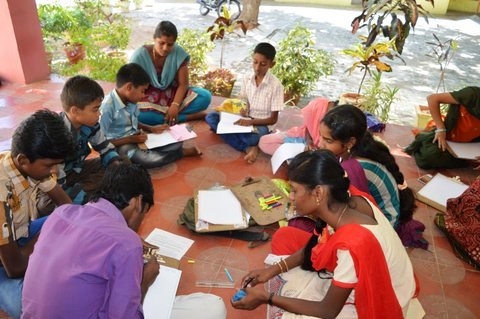 On 2nd February Fr Susai Alangaram celebrates 25 years of priesthood. He had just six years of experience as a priest in Tiruchirapally,Tamil Nadu, the southernmost state of India overlooking the Indian Ocean, when he ventured on the task of setting up a project aimed at alleviating the poverty of the children of his parish. He had encountered the Focolare Movement and committed to live for and give witness to unity with fellow priests in a caste ridden society, and with the help of two other priests he started his support at a distance project with 50 children, naming it Ilanthalir, meaning tender shoots of crops, to remind of the tender care needed for the growth and development of these children. Today poor rural children in various villages of five districts of Tamil Nadu are supported by Ilanthalir in an area stretching 125km further south from Tiruchirapally and 70km to the North. After the 2004 Tsunami children from two coastal villages were also sponsored, and they are presently following their university studies.
On 2nd February Fr Susai Alangaram celebrates 25 years of priesthood. He had just six years of experience as a priest in Tiruchirapally,Tamil Nadu, the southernmost state of India overlooking the Indian Ocean, when he ventured on the task of setting up a project aimed at alleviating the poverty of the children of his parish. He had encountered the Focolare Movement and committed to live for and give witness to unity with fellow priests in a caste ridden society, and with the help of two other priests he started his support at a distance project with 50 children, naming it Ilanthalir, meaning tender shoots of crops, to remind of the tender care needed for the growth and development of these children. Today poor rural children in various villages of five districts of Tamil Nadu are supported by Ilanthalir in an area stretching 125km further south from Tiruchirapally and 70km to the North. After the 2004 Tsunami children from two coastal villages were also sponsored, and they are presently following their university studies. 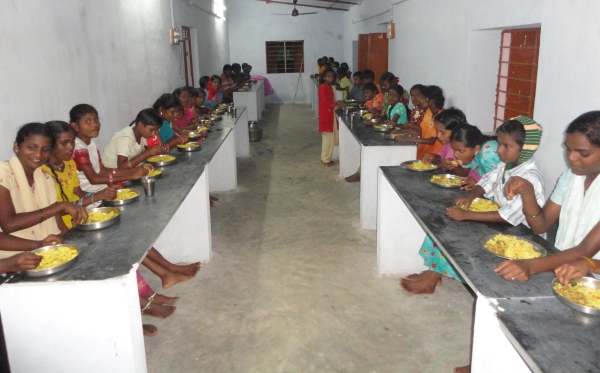 The climate in Tamil Nadu is always hot and the monsoons are unpredictable, disrupting crop cultivation and impoverishing farmers. This year there were floods in the northern part of Tamil Nadu and drought in the centre. Many families below the poverty line are more concerned with earning than educating their children, and this gives rise to illiteracy and child labour. Ilanthalir seeks to provide children with their basic necessities and sponsors their education until they are able to find employment and assist their families.
The climate in Tamil Nadu is always hot and the monsoons are unpredictable, disrupting crop cultivation and impoverishing farmers. This year there were floods in the northern part of Tamil Nadu and drought in the centre. Many families below the poverty line are more concerned with earning than educating their children, and this gives rise to illiteracy and child labour. Ilanthalir seeks to provide children with their basic necessities and sponsors their education until they are able to find employment and assist their families.  This year 456 children are benefiting from direct support and 300 more are receiving assistance from Ilanthalir. As the children are of different faiths Ilanthalir makes arrangements for all to celebrate together their major festivals of Diwali (feast of light), Pongal (harvest festival), Christmas, etc. October is observed as the month for the protection of the environment, and each centre organizes a programme of tree planting, cleaning up of public places, etc. What is striking about the Ilanthalir experience is the impact of the spirituality of unity in a context which would otherwise lead to a culture of survival and isolation. The Word of Life of the Focolare, a commentary on how to live Gospel phrases, is translated into Tamil and distributed to the children and their parents, and once a month they come together to share how they are striving to live the word of God and to renew their commitment to live it. A one day Mariapolis for around 300 people is held every year in Tiruchirapally promoting fraternal interaction. The effort of the children of Ilanthalir to live in this way and their small acts of love make them agents of unity in the family and in their neighbourhood, bringing new hope to many.
This year 456 children are benefiting from direct support and 300 more are receiving assistance from Ilanthalir. As the children are of different faiths Ilanthalir makes arrangements for all to celebrate together their major festivals of Diwali (feast of light), Pongal (harvest festival), Christmas, etc. October is observed as the month for the protection of the environment, and each centre organizes a programme of tree planting, cleaning up of public places, etc. What is striking about the Ilanthalir experience is the impact of the spirituality of unity in a context which would otherwise lead to a culture of survival and isolation. The Word of Life of the Focolare, a commentary on how to live Gospel phrases, is translated into Tamil and distributed to the children and their parents, and once a month they come together to share how they are striving to live the word of God and to renew their commitment to live it. A one day Mariapolis for around 300 people is held every year in Tiruchirapally promoting fraternal interaction. The effort of the children of Ilanthalir to live in this way and their small acts of love make them agents of unity in the family and in their neighbourhood, bringing new hope to many.
https://vimeo.com/155014979
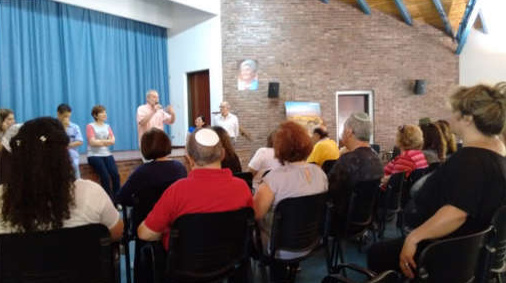
Jan 17, 2016 | Focolare Worldwide
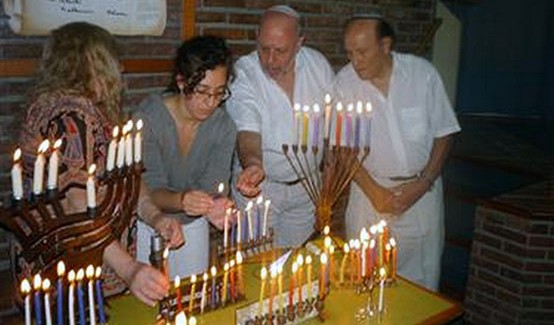 “We wanted to give a testimonial of an experience which has transformed us, and that took place on 11-13 December 2015. On this occasion some members of the Jewish Bet-El Community and the inhabitants of the Focolare town, prayed for one another,” wrote the Argentinean Rabbi, Silvina Chemen and Carlos Becaría and Nanni Espinosa of Mariapolis Lia. A special Shabbath. “We started by gathering bread for the rit,” Silvina recounted, “then we participated and shared this moment in which the Hanuka candles were lit, and we recalled the historical pact celebrated by Chiara Lubich and the Jews of Buenos Aires in 1998. Under the trees, we sang together and waited for the sunset to receive the stars that announced the arrival of the Shabbath. And then hand in hand, we entered the hall which was transformed into a synagogue for the occasion. Together we prayed the Shabbath vespers, and shared the Saturday morning prayer and the reading of the Torah scroll. It was a sacred moment.”
“We wanted to give a testimonial of an experience which has transformed us, and that took place on 11-13 December 2015. On this occasion some members of the Jewish Bet-El Community and the inhabitants of the Focolare town, prayed for one another,” wrote the Argentinean Rabbi, Silvina Chemen and Carlos Becaría and Nanni Espinosa of Mariapolis Lia. A special Shabbath. “We started by gathering bread for the rit,” Silvina recounted, “then we participated and shared this moment in which the Hanuka candles were lit, and we recalled the historical pact celebrated by Chiara Lubich and the Jews of Buenos Aires in 1998. Under the trees, we sang together and waited for the sunset to receive the stars that announced the arrival of the Shabbath. And then hand in hand, we entered the hall which was transformed into a synagogue for the occasion. Together we prayed the Shabbath vespers, and shared the Saturday morning prayer and the reading of the Torah scroll. It was a sacred moment.”  Sharing and dialogue. “In the afternoon, there was an equally important event for the Jews –Carlos narrates – which consisted of a preparation for the mass. We had anticipated their request to participate and thus fixed the schedule. During the prayer of the faithful, one special prayer was for peace and dialogue among us (Bet-El Community and the Focolare) we all were deeply moved. This feeling of unity continued all afternoon in a workshop on dialogue, with the participation of all the Christian youth who attend the town’s school. We shared our queries, doubts, expectations on dialogue and our various traditions, with liberty and depth. We concluded by decorating the Christmas tree on which we also hung our secret wishes.” End of the Shabbath. “Then we all gathered in the open air, Nanni continued – to each light our candles until a circle of light was formed. Then the sound of the Shofar horn, as the Bible explains, accompanied the rite since it was another sacred moment.” We did not only pray, but also shared artistic talents in «an evening filled with joy and harmony, where once again Chiara Lubich’s presence was felt through a painting which Sofia of the Bet-El Community offered as a gift to the town. She had also participated in the meeting last year, and felt personally addressed by the message and the figure of Chiara,» Carlos added. On Sunday there was a tour of the town. “After having reflected on some aspects of the history and the spirituality of the Movement – Nanni said – they visited the various sectors of the town and the day ended in the Vittorio Sabbione Auditorium. A new depth and God’s presence among us were felt in the reading of the First Testament. Those of us who remained in the Mariapolis felt that something had changed in us, and those who returned to Buenos Aires departed with the joy of the discovery of new brothers and sisters. And this was confirmed in the impression of one Jewish participant: ‘It is my third time here in Mariapolis Lia. Every time I left it was with the desire to return. Today instead, I feel part of this experience, and this town is now part of me as I am part of it.’ Next year’s schedule has been set!” Gustavo Clariá
Sharing and dialogue. “In the afternoon, there was an equally important event for the Jews –Carlos narrates – which consisted of a preparation for the mass. We had anticipated their request to participate and thus fixed the schedule. During the prayer of the faithful, one special prayer was for peace and dialogue among us (Bet-El Community and the Focolare) we all were deeply moved. This feeling of unity continued all afternoon in a workshop on dialogue, with the participation of all the Christian youth who attend the town’s school. We shared our queries, doubts, expectations on dialogue and our various traditions, with liberty and depth. We concluded by decorating the Christmas tree on which we also hung our secret wishes.” End of the Shabbath. “Then we all gathered in the open air, Nanni continued – to each light our candles until a circle of light was formed. Then the sound of the Shofar horn, as the Bible explains, accompanied the rite since it was another sacred moment.” We did not only pray, but also shared artistic talents in «an evening filled with joy and harmony, where once again Chiara Lubich’s presence was felt through a painting which Sofia of the Bet-El Community offered as a gift to the town. She had also participated in the meeting last year, and felt personally addressed by the message and the figure of Chiara,» Carlos added. On Sunday there was a tour of the town. “After having reflected on some aspects of the history and the spirituality of the Movement – Nanni said – they visited the various sectors of the town and the day ended in the Vittorio Sabbione Auditorium. A new depth and God’s presence among us were felt in the reading of the First Testament. Those of us who remained in the Mariapolis felt that something had changed in us, and those who returned to Buenos Aires departed with the joy of the discovery of new brothers and sisters. And this was confirmed in the impression of one Jewish participant: ‘It is my third time here in Mariapolis Lia. Every time I left it was with the desire to return. Today instead, I feel part of this experience, and this town is now part of me as I am part of it.’ Next year’s schedule has been set!” Gustavo Clariá

 The festival took place in the park of Szeged, city in the south of Hungary and was “the biggest open-air, free of charge event of the year .” It was publicized at the Open Air Festival, in a press release, and distinguished itself for the great number of participants and performances. But what was the novelty of this event? «When, a few years ago they announced for the first time a possible Christian manifestation at city-level, no one thought that such an ambitious project could ever come about in our country, », wrote Új Város, the Focolare Magazine in Hungary. «It was not just the dream of a single person, but of the ecumenical group of pastors of that city. A dream which, a year and a half ago, started to take form, involving various religious, civil and political associations, » until it gave rise to the Festival held from 25 to 27 September. As Orsolya Szlaukó, an evangelical lady-pastor affirmed: «In Szeged, the ecumenical group of pastors that lance the idea of organising something that would announce Christianity. The logo and four colours and also the entire Festival drew inspiration from a Psalm: “the Lord led me out ” (Psalm, 18). We dreamt and thought of making a gift to the inhabitants of Szeged, by showing the unity of the Christian churches and the values of these communities. ». An organizer affirmed; «Our mission addresses the city and not only our communities», and another organizer, Sándor Tari added: «Our role was to ensure the good flow of the event, and not that of being in the limelight.» Another organizer added: «During the Festival each of us found the program which suited him best, from the youth to the elderly, » and the lady-pastor concluded: «We made room for concerts, round tables, playgrounds and stands of various organizations. ». «The 60 stands disseminated like huts along the park’s avenues, formed four city districts that showed the visitors the initiatives under way: an electrician held a workshop for kids, a healthcare stand which was visited by 700 people, with blood donation, and there were university professors who gave lessons. The parishes and the ecclesial communities held a great variety of creative initiatives.»
The festival took place in the park of Szeged, city in the south of Hungary and was “the biggest open-air, free of charge event of the year .” It was publicized at the Open Air Festival, in a press release, and distinguished itself for the great number of participants and performances. But what was the novelty of this event? «When, a few years ago they announced for the first time a possible Christian manifestation at city-level, no one thought that such an ambitious project could ever come about in our country, », wrote Új Város, the Focolare Magazine in Hungary. «It was not just the dream of a single person, but of the ecumenical group of pastors of that city. A dream which, a year and a half ago, started to take form, involving various religious, civil and political associations, » until it gave rise to the Festival held from 25 to 27 September. As Orsolya Szlaukó, an evangelical lady-pastor affirmed: «In Szeged, the ecumenical group of pastors that lance the idea of organising something that would announce Christianity. The logo and four colours and also the entire Festival drew inspiration from a Psalm: “the Lord led me out ” (Psalm, 18). We dreamt and thought of making a gift to the inhabitants of Szeged, by showing the unity of the Christian churches and the values of these communities. ». An organizer affirmed; «Our mission addresses the city and not only our communities», and another organizer, Sándor Tari added: «Our role was to ensure the good flow of the event, and not that of being in the limelight.» Another organizer added: «During the Festival each of us found the program which suited him best, from the youth to the elderly, » and the lady-pastor concluded: «We made room for concerts, round tables, playgrounds and stands of various organizations. ». «The 60 stands disseminated like huts along the park’s avenues, formed four city districts that showed the visitors the initiatives under way: an electrician held a workshop for kids, a healthcare stand which was visited by 700 people, with blood donation, and there were university professors who gave lessons. The parishes and the ecclesial communities held a great variety of creative initiatives.»  Sándor Tari worked for a whole year on the setup of the stands area. «The aim was to represent every sector of the city: from the farmers, labourers, culture, healthcare… The condition set for the exhibition stands was to be open to friendship with the organisers and among themselves. Also the Police and Fire-fighters participated.» Sándor recounted that among the projects was to continue and probably hold another similar event in two years time. «I really liked the family atmosphere with many parents and children, » the father of a family said. But also the youth had a range of choices between the various bands that performed on stage, among which Gen Verde, Hillsong and Hungarian music groups. «Here there is an atmosphere we do not see every day, and listening to them one can feel peace in the bottom of our hearts », a young man said. The evangelical bishop Péter Gáncs, in an interview with the Duna TV Channel explained why he believed it was important for him to participate : «From the start, I liked the title of the Festival, Open Space. At times I have the impression that the churches are afraid to go all out. 25 years after the change of regime, we see that people still do not willingly go to church. So we are the ones who have to go out. That’s why I really appreciated this ecumenical get-together to go out into the square, into the streets. ». Source: Új Város n.1/2016
Sándor Tari worked for a whole year on the setup of the stands area. «The aim was to represent every sector of the city: from the farmers, labourers, culture, healthcare… The condition set for the exhibition stands was to be open to friendship with the organisers and among themselves. Also the Police and Fire-fighters participated.» Sándor recounted that among the projects was to continue and probably hold another similar event in two years time. «I really liked the family atmosphere with many parents and children, » the father of a family said. But also the youth had a range of choices between the various bands that performed on stage, among which Gen Verde, Hillsong and Hungarian music groups. «Here there is an atmosphere we do not see every day, and listening to them one can feel peace in the bottom of our hearts », a young man said. The evangelical bishop Péter Gáncs, in an interview with the Duna TV Channel explained why he believed it was important for him to participate : «From the start, I liked the title of the Festival, Open Space. At times I have the impression that the churches are afraid to go all out. 25 years after the change of regime, we see that people still do not willingly go to church. So we are the ones who have to go out. That’s why I really appreciated this ecumenical get-together to go out into the square, into the streets. ». Source: Új Város n.1/2016
 “I teach in a Catholic school in my city, Salta, in northern
“I teach in a Catholic school in my city, Salta, in northern 





 On 2nd February Fr Susai Alangaram celebrates 25 years of priesthood. He had just six years of experience as a priest in Tiruchirapally,Tamil Nadu, the southernmost state of India overlooking the Indian Ocean, when he ventured on the task of setting up a project aimed at alleviating the poverty of the children of his parish. He had encountered the
On 2nd February Fr Susai Alangaram celebrates 25 years of priesthood. He had just six years of experience as a priest in Tiruchirapally,Tamil Nadu, the southernmost state of India overlooking the Indian Ocean, when he ventured on the task of setting up a project aimed at alleviating the poverty of the children of his parish. He had encountered the  The climate in Tamil Nadu is always hot and the monsoons are unpredictable, disrupting crop cultivation and impoverishing farmers. This year there were floods in the northern part of Tamil Nadu and drought in the centre. Many families below the poverty line are more concerned with earning than educating their children, and this gives rise to illiteracy and child labour. Ilanthalir seeks to provide children with their basic necessities and sponsors their education until they are able to find employment and assist their families.
The climate in Tamil Nadu is always hot and the monsoons are unpredictable, disrupting crop cultivation and impoverishing farmers. This year there were floods in the northern part of Tamil Nadu and drought in the centre. Many families below the poverty line are more concerned with earning than educating their children, and this gives rise to illiteracy and child labour. Ilanthalir seeks to provide children with their basic necessities and sponsors their education until they are able to find employment and assist their families. 
 “We wanted to give a testimonial of an experience which has transformed us, and that took place on 11-13 December 2015. On this occasion some members of the Jewish Bet-El Community and the inhabitants of the Focolare town, prayed for one another,” wrote the Argentinean Rabbi, Silvina Chemen and Carlos Becaría and Nanni Espinosa of Mariapolis Lia. A special Shabbath. “We started by gathering bread for the rit,” Silvina recounted, “then we participated and shared this moment in which the Hanuka candles were lit, and we recalled the historical pact celebrated by
“We wanted to give a testimonial of an experience which has transformed us, and that took place on 11-13 December 2015. On this occasion some members of the Jewish Bet-El Community and the inhabitants of the Focolare town, prayed for one another,” wrote the Argentinean Rabbi, Silvina Chemen and Carlos Becaría and Nanni Espinosa of Mariapolis Lia. A special Shabbath. “We started by gathering bread for the rit,” Silvina recounted, “then we participated and shared this moment in which the Hanuka candles were lit, and we recalled the historical pact celebrated by